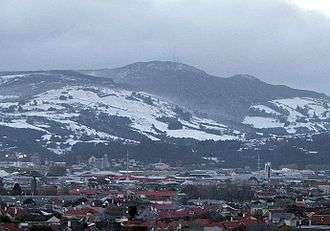Mount Cargill

Mount Cargill, known in Māori as Kapukataumahaka,[1] is a 676-metre-high (2,218 ft) volcanic outcrop which dominates the skyline of northern Dunedin, New Zealand. It is situated some 15 kilometres (9 miles) north of the city centre.
The peak is named for Captain William Cargill, an early leader of the Province of Otago. It is one of the youngest parts of the massive extinct Dunedin shield volcano and was formed some 10 million years ago.
From the summit, views can be obtained of the entire Dunedin urban area, as well as a considerable stretch of open countryside and much of Otago's coastline, from Shag Point near Palmerston to Nugget Point in The Catlins. Particularly notable is the view of the Otago Peninsula and Otago Harbour, the entire length of which can be seen from the summit.
To the northeast of Mount Cargill's peak are several smaller peaks including Mount Zion, Mount Holmes and (most notably) Buttar's Peak.

Māori legend tells of the mountain showing the profile of a prominent warrior, and indeed from Dunedin Buttar's Peak and Mount Cargill between them do form the outline of a reclining figure, with Buttar's Peak being the head and Mount Cargill the body.
A rough road from the end of Pine Hill Road provides vehicular access to the summit, and several walking tracks also lead to the top, notably a 4-kilometre (2.5 mi) walk from Bethune's Gully in North East Valley at the northern end of Dunedin's urban area and a 6-kilometre (3.7 mi) walk though Graham's Bush, which starts in Sawyers Bay close to Port Chalmers. These tracks pass through regenerating native bush and volcanic outcrops before a sharp climb along the northern flank immediately below the summit.[2]
The tracks pass two significant points of interest. One of these is a prominent formation of columnar jointed basalt known as the Organ Pipes. Similar outcrops are found elsewhere in the Dunedin area, at Blackhead near Waldronville and at Second Beach, Saint Clair. The second point of interest is the small temperate cloud forest which dominates the vegetation of the upper slopes. Though not a true cloud forest, in that it is not tropical, it bears many of the hallmarks of true cloud forest, with abundant moss and fern cover under thick low canopy.
The cloud forest is protected within a 1.8-square-kilometre (0.69 sq mi) reserve, which includes the peak of the mountain as well as several secondary peaks. Although the tracks are easy (but steep), care should be taken by walkers, as the weather conditions on Mount Cargill are notoriously unpredictable and can change very rapidly.


Transmitting station
The Mount Cargill transmitting station sits atop the mountain, broadcasting television and FM radio to Dunedin and the eastern Otago area. The station was completed in 1970, and features a 104.6-metre (343 ft) mast,[2] the tallest structure in Dunedin.
The following television stations and radio stations broadcast from Mount Cargill:[3][4][5]
- Television stations
- TV One - channel 2
- TV2 - channel 4
- TV3 - channel 9
- C4 - channel 11
- Freeview|HD multiplex A (TVNZ) - channel 43
- Māori Television - channel 44
- Freeview|HD multiplex B (MediaWorks) - channel 45
- Freeview|HD multiplex C (Kordia) - channel 53
- Trackside - channel 56
- Prime - channel 60
- Channel 9 Dunedin - channel 62
| Radio stations | Transmit Channel | Transmit Frequency | Band | Power (kW) |
|---|---|---|---|---|
| Flava | 88.6 MHz | VHF | 8 | |
| Classic Hits | 89.4 MHz | VHF | 8 | |
| The Sound | 90.2 MHz | VHF | 8 | |
| Radio One | 91.0 MHz | VHF | 2.5 | |
| The Edge | 91.8 MHz | VHF | 100 | |
| Radio New Zealand Concert | 92.6 MHz | VHF | 32 | |
| The Rock | 93.4 MHz | VHF | 8 | |
| Life FM | 94.2 MHz | VHF | 1 | |
| ZM | 95.8 MHz | VHF | 16 | |
| Radio Live | 96.6 MHz | VHF | 40 | |
| More FM | 97.4 MHz | VHF | 40 | |
| The Breeze | 98.2 MHz | VHF | 40 | |
| Radio Dunedin | 99.8 MHz | VHF | 2.5 | |
| Mai FM | 100.6 MHz | VHF | 4 | |
| Reserved – The Radio Network | 104.6 MHz | VHF | 8 | |
| Otago Access Radio | 105.4 MHz | VHF | 8 | |
| Radio Hauraki | 106.2 MHz | VHF | 8 |
References
- ↑ Place names on Kāti Huirapa Runaka ki Puketeraki website, viewed 2012-01-04
- 1 2 Hamel, A. (2008). Dunedin tracks and trails. Dunedin:Silver Peaks Press. pp. 5.14-5.17
- ↑ http://www.lincrad.co.nz/transmittersites.html
- ↑ "Tuning - Channel 9". Retrieved 2010-08-24.
- ↑ "Dunedin/Mount Cargill FM transmitter info". Retrieved 2010-08-24.
Sources
- Automobile Association (1987). AA Guide to Walkways: South Island, New Zealand. Sydney: Weldon Publishing. ISBN 1-875410-19-8.
- Bishop, G. and Hamel, A. (1993). From Sea to Silver Peaks. Dunedin: John McIndoe. ISBN 0-86868-149-0.
External links
-
 Media related to Mount Cargill at Wikimedia Commons
Media related to Mount Cargill at Wikimedia Commons
Coordinates: 45°48′47″S 170°33′17″E / 45.8131°S 170.5548°E